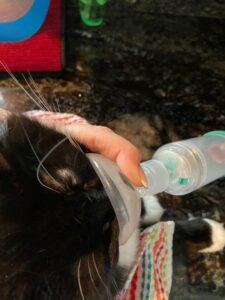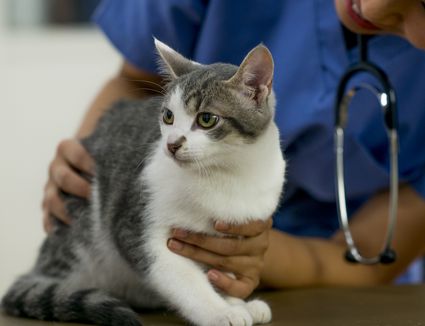Did you realize that asthma is not just a human disease, but is one of the most common respiratory diseases in cats? The disease affects between one to five per cent of cats. The average age when this condition begins is between four and five years old. So, do you know how to treat a cat with asthma?
Cat asthma is a very personal issue with me, as my favorite cat, Carlos, died due to a problem arising from his asthma. Perhaps he would have lived longer if I’d known more about the disease. I write this article hoping to help some of you who have cats with this condition.
Carlos was a beautiful tuxedo cat. A friend of a friend has a tuxedo cat with asthma,

and it is her story that prompted me to write this post.
She says her vet told her that tuxedo cats tend to be prone to asthma. My research tells me that any dark-colored cat is more apt to get the disease. Certain breeds also might have a genetic disposition to asthma. These include Siamese and Himalayan cats.
The only treatment my vet offered was a prescription for prednisolone, a corticosteroid which is the cat form of prednisone.
I hated giving the cat those pills, because of the side effects of the drug and the potential harm it could do. However, my vet gave me no other choices. As the cat responded well to the pills, I suppose the vet thought that treatment was sufficient.
From this friend, I learned that there is an inhaler made especially for cats, that could be used instead of the capsules. I wish I’d known about this treatment, because I’d have tried it. Perhaps my kitty would have lived past his 14 years.
Benefits Of Using An Inhaler
These metered dose inhalers give the kitty the benefit of delivering medication locally to the airways, thus minimizing any drug side effects to the rest of the body.
When these inhalers were developed, there were two problems with using them for cats:
- You can’t tell a cat when to inhale
- Cats tend to object strongly to the spray-off the device delivers
Infants tend to have the same problems with inhalers, so a device called a pediatric spacer was developed. The spacer consisted of a tubular chamber which is attached to the inhaler on one end and a face mask on the other. Then the infant simply breathes in the contents of the spacer.
It was discovered that the same type of spacer could be used for cats. Kitty takes seven to ten breaths from the face mask, and his dosage is complete. According to my friend, her friend’s cat takes seven breaths, once daily, and the treatment keeps the asthma under control.
If You Need An Inhaler, Check Out the feline aerosol inhaler on Amazon
You can get a feline aerosol inhaler. It can be purchased through Amazon, and if you need one, you can order it there by going to the bottom of this page, where I feature the one from Amazon.

The device keeps the asthma attacks at bay, and allows the cat relief from his congested airways. I wish I’d known about it, as I would have gladly tried it on Carlos.
A cat with airways constricted due to asthma often uses a great deal of effort just to breathe. The actual volume of air the cat can draw into his lungs is much reduced. Sometimes a cat will be seen breathing with his mouth open to draw in more air.
The first time your cat has an asthma attack, you may think he’s trying to cough up a hairball. Look at your cat’s body posture. With asthma, the cat’s body will be hunched close to the ground, and the neck and head will be extended out and down. He’s trying to clear his airways of mucus.
Though the attack may not happen frequently, he needs to be checked out by the vet, as he could have a life-threatening episode.
Here Are Symptoms Of Cat Asthma To Watch For
- Wheezing
- Breathing rapid and difficult, taking an increased effort to breath
- Persistent cough or gagging, such as that triggered by a hairball
- Produces frothy mucus while coughing
- Has difficulty breathing after exertion
- Keeps mouth open while breathing
- Extends neck upward, gasping for breath
- Squats with shoulder hunched and neck extended and low to the ground
- Weakness and lethargy
- Throat gurgling sounds
- Swallows a great deal
- Has blue lips and gums
Even if these symptoms are intermittent, have your vet check the cat. If the lungs are inflamed, there is the risk of them developing permanent scars.
What Causes Asthma In Cats?
Asthma is immunity-related. An attack can be brought on by an allergy or stress. The cause of the cat could include pollen, grass, mold, dust mites, tobacco smoke, perfume, kitty litter, household cleaning products or perhaps a certain food.
Because of the amount of dust it can create, it is recommended that you not use a clay-based litter. Ask your vet what alternative litters are available, and get the one that has no added scent and creates as little dust as possible.
To help avoid these irritants, there are a couple of things you can do. Don’t smoke inside. Clean your house more often to eliminate dust. Avoid household cleaners and air fresheners that might be scented, as those may serve as irritants.
Another cause that might be overlooked: If your cat is overweight, it can make breathing more difficult. Keep your cat lean and fit to make his breathing easier.
How Does The Vet Diagnose For Feline Asthma?
There is no single test. First, the vet listens to kitty’s chest with a stethoscope. Sometimes a blood test is given to check for a high concentration of white blood cells. The vet might take an X-ray.
Sometimes a blood test is given to check for a high concentration of white blood cells. The vet might take an X-ray.
Carlos was coughing, and a visiting vet said he had asthma. He’d brought a portable flat-screened X-ray device that rested on the floor. The cat was laid on it and the picture taken.
My Carlos was so remarkable — the vet’s assistant laid him on the X-ray device, and he seemed to understand what was expected of him, as he just lay still while the picture was taken. Cloudiness in his lungs showed the early stages of the disease.
What Is The Treatment For Cat Asthma?
Treatment consists of two main types. The cat may be given anti-inflammatory drugs, such as corticosteroids, or medication to help dilate the cat’s air passage. This latter is often administered through an inhaler.
If the cat is having an asthmatic crisis, the fastest acting relief might come from an injection of terbutaline, as the onset of relief from such an injection is relatively rapid.
Once the crisis is past, long-term management with an inhaler may be the best method. Your vet will decide on the most effective medication to be used in the inhaler.
Glucocorticoid therapy is the main method of treatment. Be prepared to give lifelong medical therapy.
Though the cat’s symptoms may come and go, don’t assume your cat does not need medication. The asthma is chronic, progressive, and incurable, but it can be managed. Though you must not stop medicating, it is recommended that you give the cat as low a dose of corticosteroids as possible, but do not discontinue entirely.
The benefit of inhaled steroids is that they target the airways directly, with fewer side effects than oral steroids.
Though other medications are being researched, many of the drugs we humans might use are not effective on cats. Additional research may provide answers to the benefits of other therapies for cat asthma.
How To Use The Inhaler
Your cat inhaler has to have a spacer device, since you can’t tell the cat to take a breath. Make sure you get one that is specifically designed for cats.
Then you know the device will fit properly and that the medication gets delivered to your kitty’s lungs.
Get your cat used to the device before adding medication. Slowly and calmly familiarize the cat with the chamber. Give lots of love, hugs, and treats.
Start by just using the mask, gradually building up to holding it on your cat’s face for 20 to 30 seconds. Once the cat is comfortable with the mask, attach it to the chamber and get your cat used to the whole device.
With the inhaler, there is a chamber that has a specialized valve designed for the low air inflow in cats. The valve opens easily with shallow breaths; thus the medication will flow easily from the chamber into your cat’s lungs.
The inhaler comes with an inhalation indicator, which moves when your cat inhales. Thus you can confirm that the mask is sealed; you can count breaths, ensure proper use, and know the medication has been delivered.
Steps For Using The Inhaler For The Cat
Once your cat is familiar with both the mask and spacer, you can add medication. Here are the simple steps:
- Shake the inhaler and insert in back of chamber
- Apply mask gently to your cat’s face. Cover mouth and nose. The Flow-Vu indicator moves to provide a good seal
- Depress inhaler to release medication
- Use the inhalation indicator to count seven to ten breaths, then remove from your cat’s face.
- After treatment, remove any residual medication on fur with a damp cloth
I hope this information is helpful. Perhaps you can add years to your cat’s life by treating his asthma properly. If you need more information, please read through the references that I used to write this article:
thesprucepets.com/treat-feline-asthma-555454
purina.com/articles/cat/litter/understanding-cat-asthma
veterinarypartner.vin.com/default.aspx?pid=19239&id=4951536
bluecross.org.uk/pet-advice/caring-cat-asthma
petcarerx.com/article/how-to-treat-dog-and-cat-asthma/622
If you need to purchase a cat inhaler, you can get a feline aerosol chamber inhaler from Amazon. Click on the image or the blue highlighted text below. Please note that, as an Amazon affiliate, I may receive a small commission from your purchase.
Feline Aerosol Chamber Inhaler
Helps cats with breathing & delivering medication
By lifevv
Price: $20.88
Prime


